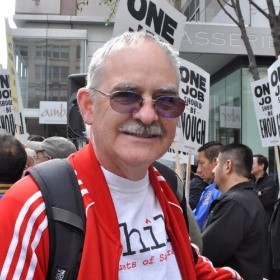JANUARY 30, 2023
Thanks to Sen. Wiener and our own delegation, San Francisco may be in serious trouble in four years—and it won’t be the city’s fault.
I have been talking to folks at the City Planning Department to follow up on my analysis of the numbers in the Housing Element, and after a good amount of research, I think can fairly conclude the following:
The state, thanks to the likes of Sen. Scott Wiener, has totally screwed San Francisco.
Here’s what’s really going on:
Under Wiener’s state law, every city has to submit a plan, which in SF has become part of the Housing Element, that shows how the community is going to meet its Regional Housing Needs Assessment goals. The RHNA process is ridiculous and the goals are a farce.
Welcome to Houston, which has no zoning at all. Is that how we want to live? (Wikimedia Commons image from Houston Medical Center)
Nevertheless, if San Francisco doesn’t show progress toward meeting those goals, the city could lose out on transportation and housing money (imagine: if we don’t have enough money to fund enough affordable housing, they will take away affordable housing money; what a brilliant, effective plan.)
More: If the state decides to decertify the city’s Housing Element, which could happen four years from now, then San Francisco in effect loses all control over local development and developers can build anything they want, almost anywhere they want, with very little public input or oversight.
That’s what’s called the “Builder’s Option”—and it’s a very real threat to San Francisco.
Here’s why:
The RHNA goals call for San Francisco to zone for, make room for, and approve about 82,000 new housing units in the next eight years, 46,000 of them affordable.
In theory, Miriam Chion, director of community equity for the department, told me, the private market could build housing that meets the affordability standards. But she agreed that’s never going to happen, so the city, with whatever resources it can find, is supposed to subsidize 46,000 units, at a cost of about $19 billion. Nobody in any position in City Hall has any idea where that money will come from. (If the city relies entirely on inclusionary housing from private developers, it will require massive demolition of existing housing and neighborhoods.)
The RHNA goals call for about 36,000 new units of market-rate housing. The city has already approved and entitled some 45,000 units, about 35,000 of them market rate.
In other words, San Francisco has already essentially met the bar for approving luxury housing, without any additional upzoning or streamlining at all. Chion and Planner James Pappas, who has done a lot of the analysis for the Housing Element, both agreed with me that in terms of approvals, San Francisco doesn’t lack for market-rate housing.
But that’s only half of the story.
When the clock starts ticking on the city’s new Housing Element Feb. 1, the state is going to look beyond approvals and start demanding building permits. “They will want to know how many of these approved developments get permits,” Chion told me.
But that’s a huge problem, because the city can’t force private developers to build anything—and right now, because of circumstances way beyond the city’s control (including the cost of construction materials and the Federal Reserve’s hike in interest rates), none of those developers are building. There’s not enough profit in it.
So if private developers don’t decide to build in San Francisco—even when they have already gone through all of the allegedly obstructive process and have their entitlements—the state will blame the city.
Because of various complex numbers in the Housing Element, Pappas said, the state is going to mandate building permits for 29,000 units by 2027. About half will need to be affordable housing.
If that doesn’t happen—and I don’t know any reasonable person who thinks this is remotely possible in today’s market and with existing resources—then there are two possible outcomes:
The city could even further open up zoning rules and further remove “obstacles” like public hearings and community input, in the desperate hope that developers would then start building. Among the obstacles that the city could remove are the affordable-housing inclusionary rules, meaning even less affordable housing would be built. The city could be forced to allow more development in more areas, which could mean demolitions of existing housing and neighborhoods.
(For the record, I am not against density, and I agree that the West Side of town should have more housing, but it’s clear that density doesn’t always means affordability. This is, in the end, all about developer profits.)
Or the state could decertify the Housing Element, at which point all local rules are off, and the Builder’s Option will take effect.
Pappas and Chion told me they don’t think the Builder’s Option is likely. I hope they’re right. But it’s exactly what state legislation allows.
Oh, and the planners didn’t suggest this, but at least one developer has: The private developers could demand city subsidies for their profit-making housing, and threaten not to build if we all don’t go along.
So let’s sum this up: The state Legislature, led by the city’s own delegation, has set an impossible bar for San Francisco to meet, and is prepared to impose severe penalties if the city doesn’t meet it—even if that failure is due to factors entirely beyond the city’s control.
I am not a conspiracy theorist; really, I’m not. But I do believe that powerful political players often have plans and schemes that they keep secret.
If I were a big developer in San Francisco today, and I had some entitled projects ready to break ground, I could see a really strong argument for holding off, waiting a few years, and forcing the city to fail in its RHNA goals—so that I could make more money in the future by building housing with no local oversight at all.
If I were thinking that way, I would encourage the mayor to support Wiener’s Yimby approach, which she has. I would be thrilled to see a Housing Element with ambitious goals that I would encourage the mayor to make sure the city can’t meet.
Then in four years, either I would get public subsidies, or be exempt from any affordable-housing requirements—or San Francisco would become the equivalent of Houston, with no local controls on building housing, and I could go to town. (San Francisco could still have zoning, but no other requirements for housing—and the state would push back on any zoning that it finds to be an “obstruction.”)
But that sort of thing doesn’t really happen. Right?
Tim Redmond has been a political and investigative reporter in San Francisco for more than 30 years. He spent much of that time as executive editor of the Bay Guardian. He is the founder of 48hills.

 Tim Redmond
Tim Redmond